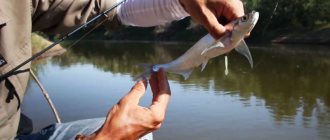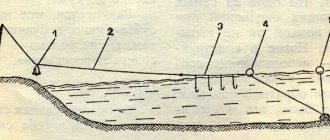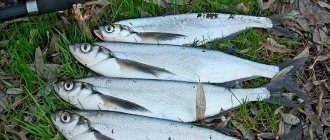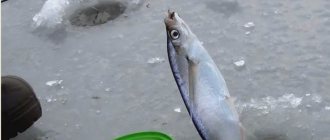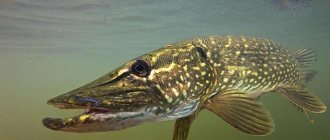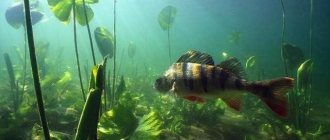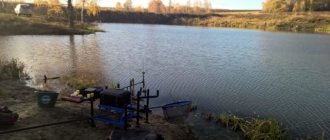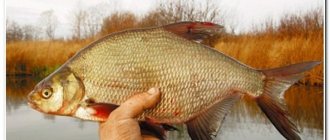Catching sabrefish is spectacular and interesting in its process. A frisky and stubborn fish, actively resisting when caught, is capable of delivering a lot of positive emotions to the lucky owner of the bite, from high jumping candles to high-speed, rapid departures from the coastlines at the last stage of fishing. In addition, by wisely choosing a place to cast bait and keeping a school of hungry fish at the point, the angler will receive such high-speed fishing that it will be difficult to surpass when catching any other type of fish.
Chekhon meat has high gastronomic properties, especially when dried, and trophies include saber specimens, which is what this fish is called in many places, and up to 500–700 grams. In continuation of our article, we will talk about how you can catch saberfish with various types of gear and where to find a school of this frisky fish in a reservoir during the most favorable period of the year, when sabrefish are most actively biting.
Chekhon of the Pripyat River
Chekhon feels great in this river of ours, actively reproduces and can reach very impressive sizes - my personal record is 67 cm. But usually the catches are dominated by fish 30 - 40 cm long.
In the spring, before spawning (and Pelecus cultratus spawns in our area in early May) and immediately after it, most often saberfish can be found on sandy beaches and river spits. And when the river returns to its channel, it goes to the deepest sections of the river with a strong current, where it stays until autumn.
Chekhon is a schooling fish. And the more solid the flock, the greater the chances of a stable bite. Usually, no bait is required - the sabrefish, in the fight for food, rushes at everything that comes into its field of vision. Therefore, when catching sabrefish using a sbirulino float, they even use just bunches of red thread as bait.
Well, more often - a bunch of maggots, small twisters, fly fishing flies. But sabrefish are caught on the feeder as bycatch. And when you aim to catch a large bream, its bites are very annoying. It is not always possible to react in time to the sharp twitching of the quivertype at the moment when the feeder is just sinking to the bottom with heavy tackle. And if you don’t pay attention to these “twitches”, the bait on the hook, as a rule, turns out to be chewed - and the bream simply does not react to it.
But on days when bream refuses to bite, it makes sense to engage in feeder fishing for sabrefish purposefully. It's just not very easy to do. I experimented a lot, trying to adapt the feeder for this purpose: I installed the lightest feeders, lengthened the leash, and even hung an additional polystyrene ball near the hook.
However, fishing with sbirulino still turned out to be more effective. But the experiments continued. Slowly I began to understand the technique of presenting bait - and the puzzle came together. Feeder gear turned out to be especially effective on days when there were few flying insects above the water, so saberfish did not feed in the upper layers of water.
Catching sabrefish with an elastic band
Fishing elastic for sabrefish can be of different designs and modifications.
In this video, the rubber band tackle is presented in its simplest form, because fishing with a rubber band doesn’t have to be complicated. The rubber band video, the possibilities of which you can see in this video, is combined with the moment when fishing with an elastic band is shown in full. After all, donka gum is not only easy to obtain, but also making gum for saber fish will not take you much time. This video shows in great detail and step by step how to make an elastic band for successful fishing for saberfish. Equipping an elastic band for a case The design of the elastic band used here is very simple, but at the same time practical. Such rubber bands are sold in any fishing store from 40 rubles apiece, but without weight. A fully equipped tackle in a fishing store costs about 100 rubles.
We make an elastic band for catching sabrefish with our own hands. We will need:
- heavy load weighing from 500 g to 1 kg;
- rubber shock absorber 5-10 m long;
- main line 0.35 thick, 30-50 m long;
- fishing line 0.25-0.3 for leashes; several carabiners (swivels) with clasps;
- 4-5 hooks No. 7-8 according to Russian numbering;
- a buoy or float (optional) to pull the gear out of the water if it was lowered from the boat.
Equipment for rubber bands for catching sabrefish:
- A heavy iron part or lead casting is suitable as a load.
- A strong rope 0.5-1 m long is tied to the load.
- Particular attention is paid to the elastic band, which must be of high quality, fresh, without scuffs, cracks or tears.
- A loop is made at both ends of the elastic with a double knot; first you need to moisten these areas with water.
- Now you need to attach the swivels to the elastic loops.
- You can connect the elastic band to the weight rope using a winding ring or latch.
- A working section of the main fishing line 4-5 m long is attached to the other end of the elastic band, onto which 3 to 6 leashes with hooks 30-50 cm long are mounted.
- Leashes can be attached to the main line using a loop-to-loop method or using a carabiner.
Catching sabrefish using a spinning rod
Tackle
- Rod: Length 2.4-2.7 meters. A long cast is required when fishing from the shore. From a boat, rods up to 2.4 meters long are suitable. The preferred rod class is ultralight.
- When fishing for sabrefish using a spinning rod, you must use a spinning reel, which makes it possible to cast light baits over long distances. Its size is selected based on the power of the fishing rod used, the thickness of the fishing line and the weight of the bait.
- Fishing line: braided, the most preferred choice is 0.15 mm.
Lures
- Small silver-colored Kastmaster spinners have proven themselves well when catching sabrefish. The oscillating spoon is driven evenly, without pauses or accelerations. You can also use stepped wiring in the middle layers of water.
- For hunting for sabrefish, spinners such as Mepps Aglia numbers 00, 0 and 1 are suitable, as well as small models of Blue fox and Abu Garcia . The disadvantage of spinners is that they are difficult to cast over a long distance, and long casting can be very important when catching saberfish. When catching sabrefish with rotating lures, you can use uniform wiring in the upper layers of water. Also, when fishing with a spoon in the upper layers of water, good results can be achieved by fishing with periodic jerks and short stops, during which the bait goes down 20 - 30 cm.
- Use small twisters measuring 1 or 2 inches.
- Small floating wobblers are suitable for catching saberfish. Small wobblers used for catching saberfish cannot be thrown over a long distance. Getting out of this situation when fishing on a river is quite simple: positioned upstream, you need to float the bait to a school of fish , and then start retrieving.
Equipment requirements
If you want to target sabrefish using a feeder, you will need a high-quality lightweight rod. The rod with which bream is caught (usually with a test weight of 80 - 120 g) turns out to be too rough for high-speed fishing of sabrefish. When biting, the fish immediately feels resistance and throws the bait. Although the fisherman sees a bite (several distinct pokes), it usually never comes to an effective hook.
Most often I use two models of rods, both of them are 3.3 m long, but they differ in construction and test. One model (to be specific - Team Salmo Dominant , test up to 40 g) is softer, and it is convenient to fish with it when you find a large school of sabrefish, so no special accuracy is required in casting. But when fishing conditions are such that you need to hit some local point with the feeder, I use the tougher Pride MC model with a dough of up to 50 g and good accuracy of “shooting”.
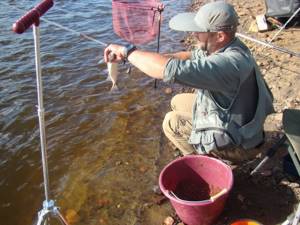
When biting, the graceful blanks of these pickers load very smoothly - and the fish have enough time to swallow the bait. And how they work when fishing! Chekhon is desperately fighting for its life - and if the gear is set up incorrectly, gatherings near the shore are a very frequent occurrence. At one time I tried to work part-time as a reel clutch, but the jerks of the sabrefish are always so lightning fast that it is simply impossible to manage to adjust the optimal braking force by quickly rotating the brake adjuster. But with a light rod, the problem is solved very simply: the fish “rides” on it, as if the rig has a life-saving feeder - and comes to the shore completely tired. I just have to take it in my hand.
In addition to the fishing rod, you will need a stable tripod or stand with a long soft stand. And even if such equipment does not look like a river, but with a wide stand it is extremely convenient to hook if the bite occurs at the moment when the feeder is just lowering in the water column. And when fishing for sabrefish, such bites happen quite often.
How to catch saberfish on a feeder?
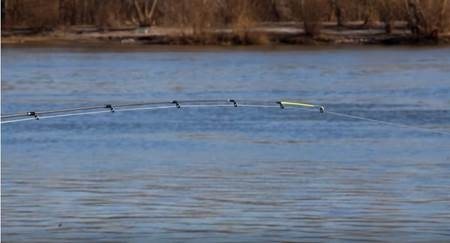
Catching sabrefish on a feeder is different from catching other fish. For roach, bream and crucian carp, the classic feeder approach is used. That is, first we find a promising point, feed it with 5-10 feeders and begin to actively fish. When fishing for sabrefish, the tactics are somewhat different. There is no need to look for a point. We need to look for areas where schools of fish most often pass. During the pre-spawning period, roaches are also caught this way, by the way. Usually the flocks pass at a decent distance from the shore. On some days, saberfish come closer to the shore. Simply put, we need to throw the tackle “at the fish,” as it is called in fishing slang.
In this case, we use the fan method and do not clip. They threw the tackle at one point. We waited about 20 minutes. There is no bite, we throw to the left or to the right. It wouldn’t hurt to see at what distance your neighbors are fishing. If you decide on the distance, then it will be easier. At this stage, two feeders can be used. Then, when we have already identified a cool place, the second feeder can be removed.
It happens that the saberfish starts to move. The moment the bait hits the water, it can greedily swallow it. Light stretches also help. Several turns of the reel set the foam with maggots in motion, and the saber fish reacts to this with bites.
Sometimes you can change your fishing spot by moving slightly to the left or right. Such movements often lead to bites and good catches.
It happens that on some reservoirs, saberfish take better on white foam, while on others only on green or yellow. Therefore, it is better to have polystyrene foam of different colors - assorted, so to speak.
As for the frequency of casting, we do them every five minutes. We don’t sit like over donks. Some casts provoke fish to bite. By the way, roach often gets caught on a hook when fishing for sabrefish. She also takes on the fly, preventing the feeder and bait from landing.
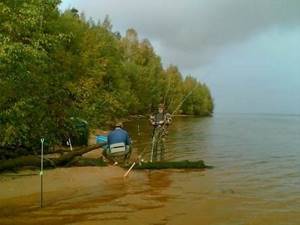
In general, sabrefish bites are brisk. She usually takes greedily, without twitching that irritates the fisherman. Usually, if a fish is on a hook, it sits on it very securely. Therefore, when fishing, it is important to have a good extractor so as not to have difficulty removing the hook. In some ways, these bites can be compared with chub bites. He also takes the nozzle without hesitation.
A few words about feeder casts. Sometimes you can see a situation where a fisherman has cast a feeder and immediately lowers the rod without waiting for the feeder to sink to the bottom. It is not right. After casting, the rod must be held parallel to the shore, so that it is directed towards the flying arc. As soon as the feeder reaches the water, we raise the rod, thereby reducing the load on the tip of the rod. After such a cast, we will not have a large loop, which we then have to remove by reeling in the line with a reel.
Coil
And here I had to experiment a lot. Conventional spinning models can also be considered as a reel for catching sabrefish using bottom gear, but in reality their brake settings turn out to be too rough - and this causes a lot of fish escapes.
Match reels with a large spool usually have a soft drag, but are too heavy. And with constant swinging of the rod, a few “extra” tens of grams turn into kilograms by the end of fishing. Match reels with a large gear ratio and a small spool for a feeder, even a light one, turn out to be too gentle.
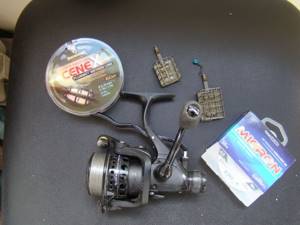
In the end, I opted for an Allux , equipped with a lever for instant brake locking. By pressing this lever with my index finger, I can very smoothly and quickly adjust the braking force in the process of hooking and landing fish.
Main line
I use only monofilament as my main fishing line for saberfish. Unlike non-stretch braid, monofilament line gives me an additional advantage when landing fish. And it makes much less noise through the rings than the cord. It would seem like a trifle? But saberfish have good hearing, and are very wary of any extraneous noise.
When fishing near the shore, the quietness of the monofilament line allows me to see several dozen additional bites. Chekhon, although it resists fiercely, does not shine with outstanding dimensions, so for catching it, a fishing line with a diameter of 0.2 mm is quite enough.
Feeder
For our purposes, models with a large cell container and a flat bottom are better suited. Such feeders are freed from food faster than others, and when reeling out the gear, the flat bottom creates additional lifting force in the water - and the feeder quickly reaches the upper layers of the water. The optimal weight of feeders is in the range of 20 - 30 g.
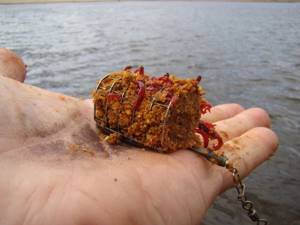
Attempts to install lighter models led to an increase in the number of bleak bites.
Choice of time and place
You can catch sabrefish on a feeder throughout the open water season - spring, summer and autumn. However, experienced fishermen purposefully catch sabrefish only for a short period of the year. Typically this period lasts about one to two weeks in May before spawning. During this period of time, sabrefish greedily rushes to any bait that falls into the water. At other times it is caught, but its bite is more passive.
Chekhon prefers cloudy and cool weather. Therefore, this fish is usually caught in the morning, evening and on cloudy days. It has been noticed that there is always a good bite before a thunderstorm or rain.
The most favorite habitat of saberfish are sand spits with rifts. In such places with a depth of up to 2 meters, the silver saber looks for food on the surface and in mid-water. This is where you need to look for schools of sabrefish, both during the feeding period and during the rest of the open water. In addition to sandy rifts, saberfish can also be found at the boundaries of currents, near the banks under overhanging trees, near sunken snags and trees, on the bottom elevations in a reservoir, at the entrances and exits of holes.
Installation of equipment
Here I also had to try to find something suitable. For catching sabrefish, all loop mounting options turned out to be too “short” - the fish quickly felt the weight of the feeder and managed to spit out the hook even before hooking. The solution was found after I started using in-line . The clip-on feeder moves freely along the main line, so when biting the fish practically does not feel the weight of the feeder. And I always have a few extra seconds to make the hook.
The diameter of the leash line ranges from 0.12 – 0.14 mm. The leash itself is not always long; its dimensions have to be adjusted on each fishing trip. When starting fishing with a meter-long leash, I gradually shorten it, ensuring that when the fish bites, they swallow the bait shallowly.
Hooks
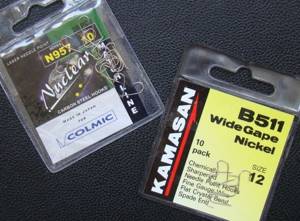
The saberfish has a large mouth and can swallow bait deeply. But with an active bite, tearing the hook out of the fish’s throat every time is not a very pleasant task. So I select hooks depending on the desired size of the trophy. But we shouldn’t increase the size of the hook too much if we’re fishing with maggots or casters - this bait looks unnatural on a large hook.
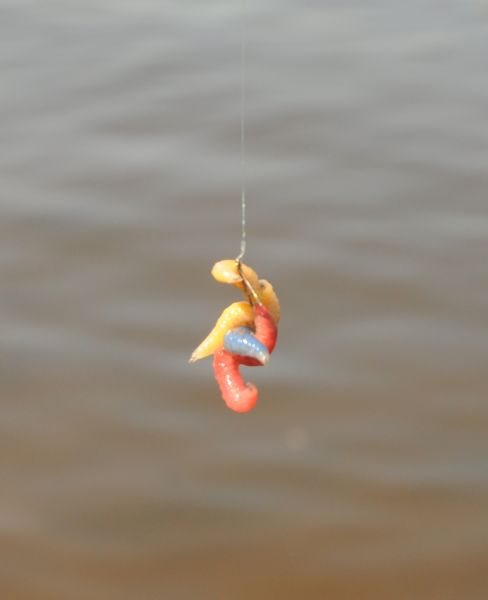
After trying various options, I settled on two models of hooks Nos. 10-12: Colmic B957 and Kamasan B511 .
Chekhon habitats, search for fishing spots
The cautious saberfish lives in reservoirs flowing into the Baltic, Black and Azov Seas. Flocks prefer large and clean rivers and reservoirs. You will not find it in lakes with “stagnant” water and small rivers. This fish swims in water with medium and fast currents, concentrated in areas of large deep-sea reaches.
Depending on the time of year, saberfish change their habitat and finding a suitable catching place is not so easy, but to a greater extent the school is located:
- In the warm season - an open deep-water area, the border of the main and reverse currents, near sunken trees and large boulders, places of whirlpools. In the summer, when many insects appear, the saberfish rises to the surface to feed. During this period, it is necessary to choose places with tilted trees above the water.
- In winter, the fish lie in bottom holes with a slow current. Finding them is quite difficult, and the fisherman has to constantly change the place where he fishes the bottom.
Lure
The saber fish responds best to active bait that is clearly visible in the water. For the names of mixtures such as “Bream”, “Roach”, etc. I haven't been paying attention for a long time. And from the arsenal of dry mixes I have, I chose Sensas Gros Gardons . This choice is not at all accidental. After all, the main thing is that the mechanical properties of the finished product are suitable for the fishing strategy I have planned. And here a significant role is played by how much water the dry mixture can “drink.”
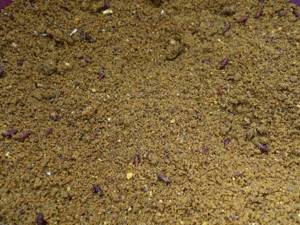
The more water it absorbs during mixing, the easier it is to simulate the properties of the finished product. Sensas baits from this series absorb water very well. With leisurely repeated soaking and thorough mixing of the bait with your hands, sometimes additional punching through the sieve is not required - the final product is obtained without a single lump. When mixing the bait, I try to get a crumbly mixture that is easily washed out of the feeder.
I achieve this by gradually soaking with small volumes of water. Initially, about 300 ml of water is added to the dry mixture. The bait is mixed well and left to ripen for about 20 minutes. Then water is added in small portions, the mixture is again thoroughly mixed by hand. At the same time, I constantly monitor that the bait always remains a little dry. As a result, the entire kneading process takes at least half an hour.
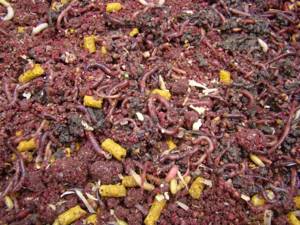
To make the bait even more noticeable, I add a handful of two-color pastoncino biscuit crumbs to it. In addition to the plant base, my bait for catching sabrefish always contains maggots, casters, chopped worms and bloodworms.
One fishing session on the Pripyat River
After the starting feeding (which is 6 - 8 balls of bait the size of an apple), which I produced using a large slingshot, the bites began almost immediately. On this day, the saberfish attacked the bait not in the water column, but in the first 20 - 30 seconds after the feeder began to roll along the bottom under the influence of the current.
To maintain the fish's appetite at the proper level, every 10 - 15 minutes I put another ball of bait the size of a large apple into the water. If no bites occurred, I quickly reeled out the tackle and reloaded it with a fresh portion of food. Attracted by bait, the fish pecked vigorously throughout the fishing. Moreover, unlike fishing with sbirulino, it was not at all frightened by either motor boats passing nearby or athletes training in kayaks. And in 4 hours of fishing I managed to catch about 15 kg of selected sabrefish.
I hope my recommendations will help you master this simple but very exciting method of high-speed fishing using a light bottom fishing rod.
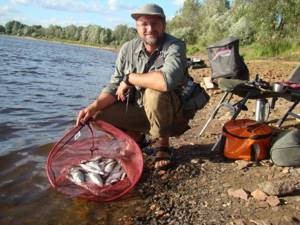
Fishing place and bait
Feeders are accustomed to probing the bottom well and making a good starting feed when fishing. Fishing for saberfish breaks this stereotype. The fish go to spawning grounds in schools, and rarely stay in one place for long to eat food. During the periods of summer, when the saber fish have spawned, bites are rather random. It disperses throughout the reservoir and there is no point in catching it purposefully - there is a better chance of catching other fish.
Here lies another point. A feeder is a piece of equipment designed for catching fish from the bottom. However, sabrefish stays half-water or near the surface. How to catch it with a feeder? You just need to find a good place with a shallow depth where the streams of water mix. Usually this is on fast river rapids. The food in such areas will not last long, and the feeder here plays a supporting role - emitting a large number of odors that will attract the attention of a passing school and allow you to catch one or two fish from it.
All options with abundant starting feeding will not work here, as well as maintaining the same fishing point. Usually on a river it is important to find the correct distance from the bank where the fish are passing and fish there. It’s a different matter in river deltas, where sabrefish gather in large flocks before spawning. There it makes sense to make a starter feed, which will allow the flock to linger, and it will not be washed away by the current after half an hour. And you need to throw it in the place where it was made. But most anglers fish on rivers.
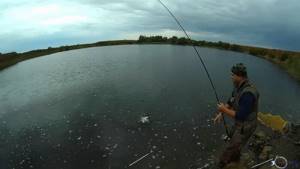
The feeder should be medium in size. Too small is bad. The food will quickly be washed out of it, and you will have to frequently refill it to fill it again. Big is also bad. It produces unnecessary waste of feed and is heavily carried away by the current. Usually the ideal size of a feeder is when the food is almost completely washed out of it and then the fish bite. It is better to have several feeders in stock with sufficient loading, but of different volumes. When a fish is caught, but there is still food left in the feeder, this is a sign that you need to change it to a smaller size.
Victoria Leshchenko
I've been working hard in the fishing tackle department for the past six years. I can help you assemble almost any gear.
Ask a Question
The type of feeder matters. Metal meshes performed best in such conditions.
They immediately begin to feed as they fall, which allows them to attract fish from long distances and quickly reach the bottom due to their low buoyancy. Chebaryukovkas and other feeders with a large wall area will not be very good for sabrefish, since they deliver most of the food to the bottom and leave little of it on the fall. You can also recommend using springs - feeders, well known in bottom fishing. They are excellent at getting rid of food when they fall. But they won’t hold the bottom perfectly, so it’s better to place them in the middle current.
